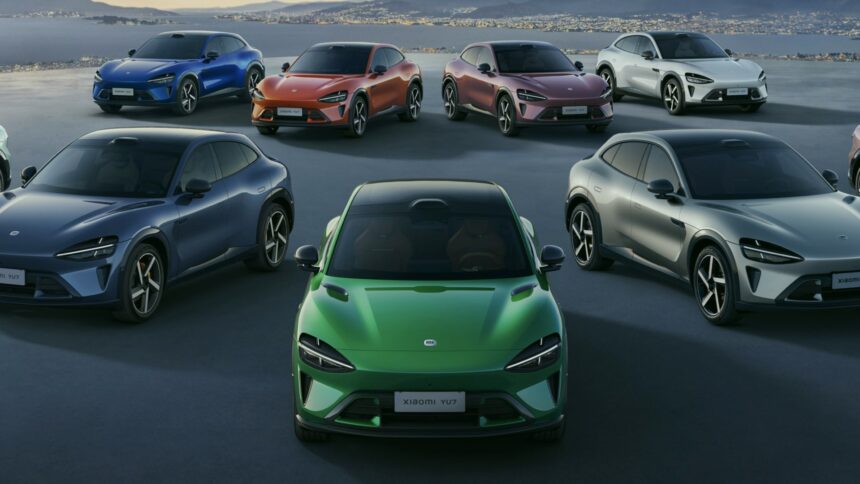When Xiaomi opened its online portal for the YU7 electric SUV at 7 p.m. on June 26, China’s shopping-app servers groaned. 289,000 buyers locked in a deposit within the first 60 minutes, a figure that ballooned to ~316,000 in 72 hours—the fastest pre-sale surge the Chinese auto industry has ever logged. This impressive performance underscores the rising demand for the Xiaomi EV.
That tidal wave arrives while the company’s first model, the SU7 sedan, is still riding a backlog so long that new customers face 350-day delivery times. With more than 25,000 SU7s delivered in June alone and cumulative output topping 271 k, Xiaomi EV is scaling faster than any Chinese newcomer since NIO’s 2020 breakout. The swift growth of Xiaomi EV reflects a significant shift in consumer preferences towards electric vehicles.
1 | Numbers that blew past Tesla—and even Xiaomi’s own record
| Launch metric | Xiaomi YU7 | Tesla Model Y (China, 2020) | BYD Song L (2023) |
|---|---|---|---|
| First-hour orders | 289,000 | ~100,000 (est.) | 56,600 |
| 72-hour orders | 315,900 | n/a | 93,257 |
| Starting price (¥) | 253,500 | 266,400 | 219,800 |
| Deliveries first full month (proj.) | 30–35 k | 12 k | 16 k |
Sources: Company filings, industry analysts, CnEVPost.
2 | Five reasons the orders poured in
a) Smartphone-style launch playbook
Xiaomi’s 351 EV showrooms mirrored its Mi Store blitz marketing: countdown clocks, live-stream influencers, and limited-time ¥2,000 “founder” rebates.
b) Aggressive sticker pricing
At ¥253,500 (~US $34 k), the YU7 undercuts a base Model Y by ¥13 k and throws in a 100 kWh LFP pack, massaging range anxiety.
c) HyperOS inside
The same UI powering 650 million Xiaomi phones now controls cabin climate, route-based battery pre-conditioning, and even your smart-home lights when you’re ten minutes from the driveway.
d) 800-V class charging
The YU7 gulps 10-80 % in 18 minutes on a 350 kW charger—on par with Porsche Taycan numbers, but at half the price.
e) FOMO marketing meets limited production
With only 8,000 YU7 build slots confirmed for July, Xiaomi stoked scarcity, echoing its “flash-sale” phone strategy.
3 | What’s under the sheet metal?
| Spec | Xiaomi YU7 | Quick take |
|---|---|---|
| Battery | 100 kWh BYD LFP (800 V) | Safer, cheaper than NMC; supports 280 kW peak |
| Motors | Dual 375 kW (503 hp) AWD | 0-100 km/h in 3.9 s |
| Range (CLTC) | 620 km | ≈ 500 km real-world |
| Software | HyperOS + Xiaomi Pilot L3 | NVIDIA Orin X today; in-house “Surge X1” SoC 2026 |
| ADAS Sensors | 1 lidar, 11 cams, 5 mm-wave radar | City NOA roll-out Q4 |
4 | SU7 backlog is still snowballing
Launched in March 2024, the SU7 sedan tallied 200 k verified orders in three minutes and has now crossed 271 k cumulative deliveries. Average daily output hovers at 900 units, but wait-lists stretch up to 350 days as Xiaomi adds a second production line in Wuhan.
5 | Investors noticed—shares at 18-month high
Hong Kong-listed Xiaomi (HK: 1810) jumped 8 % the morning after the YU7 launch, hitting an 18-month peak and adding nearly US $6 billion in market cap. Analysts at Citic Securities bumped 2025 delivery forecasts from 450 k to 520 k, citing “unprecedented brand pull.”
6 | Can Xiaomi keep up the pace?
Capacity: A third assembly plant in Taiyuan is slated for Q3 2026, lifting total annual capacity beyond 700 k.
Supply chain: Xiaomi tapped CATL for sodium-ion packs aimed at a sub-¥200 k hatchback in 2027.
Regulatory: EU anti-dumping probes could delay European exports; Xiaomi is scouting a Polish CKD site to dodge tariffs.
Service: 500+ new “Mi Auto Clinics” add collision repair to phone-style Genius Bars, quelling buyer jitters about parts and labor.
Bottom Line
With phone-launch theatrics and EV-grade hardware, Xiaomi rewrote the playbook for electric-car hype—and backed it with staggering preorder figures. Whether production can match demand remains the looming question, but for now the smartphone titan has done the unthinkable: make a Tesla launch look tame. As wait times stretch toward a year, one thing is certain—the Xiaomi car craze has only just begun.









